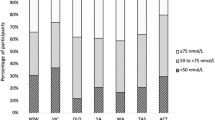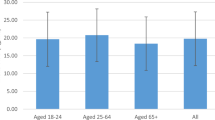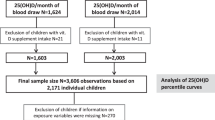Abstract
Background/objectives:
To determine seasonal variation in vitamin D status in healthy Caucasian adolescent girls and elderly community-dwelling women living in Denmark, and to quantify the impact of sun exposure and intake on the seasonal changes in vitamin D status.
Subjects/methods:
A 1-year longitudinal observational study of 54 girls (11–13 years) and 52 women (70–75 years). The participants were examined three times (winter–summer–winter). Serum 25-hydroxyvitamin D (S-25OHD) concentration and vitamin D intake were measured at each visit. Sun exposure was measured during summer.
Results:
S-25OHD concentrations (winter, summer, winter) were median (25, 75 percentiles) 23.4 (16.5, 36.4), 60.3 (42.7, 67.7), 29.5 (22.2, 40.4) and 47.2 (27.3, 61.1), 67.3 (35.1, 79.2), 50.5 (32.7, 65.5) nmol/l for girls and women, respectively. The usual sun habits were determinant (P=0.002) for change in vitamin D status from winter to summer. Vitamin D intake from supplements (P<0.0001) and diet (P=0.002) were determinants for change in vitamin D status from summer to winter. Winter vitamin D status of 50 nmol/l is achievable when vitamin D status the previous summer was ∼100 nmol/l. If summer vitamin D status is only ∼60 nmol/l, vitamin D status the following winter would be ∼28 nmol/l.
Conclusions:
Low vitamin D status among adolescent girls and elderly women during two consecutive winter seasons, improved vitamin D status during the summer and better vitamin D status in women than in girls was found. The estimations show that a summer S-25OHD concentration ∼100 nmol/l is needed to achieve a concentration of ∼50 nmol/l the following winter.
This is a preview of subscription content, access via your institution
Access options
Subscribe to this journal
Receive 12 print issues and online access
$259.00 per year
only $21.58 per issue
Buy this article
- Purchase on Springer Link
- Instant access to full article PDF
Prices may be subject to local taxes which are calculated during checkout

Similar content being viewed by others
References
Brot C, Vestergaard P, Kolthoff N, Gram J, Hermann AP, Sørensen OH . Vitamin D status and its adequacy in healthy Danish perimenopausal women: relationships to dietary intake, sun exposure and serum parathyroid hormone. Br J Nutr 2001; 86: S97–S103.
McCarthy D, Collins A, O'Brien M, Lamberg-Allardt C, Jakobsen J, Charzewska J et al. Vitamin D intake and status in Irish elderly women and adolescent girls. Ir J Med Sci 2006; 175: 14–20.
Ovesen L, Andersen R, Jakobsen J . Geographical differences in vitamin D status, with particular reference to European countries. Proc Nutr Soc 2003; 62: 813–821.
Webb AR, Kline L, Holick MF . Influcence of seasonal and latitude on the cutaneous synthesis of vitamin D3: exposure to winter sunlight in Boston and Edmonton will not promote vitamin D3 synthesis in human skin. J Clin Endocrin Metab 1988; 67: 373–378.
Heaney RP . Lessons for nutritional science from vitamin D. Am J Clin Nutr 1999; 69: 825–826.
Hollis BW . Assesment of vitamin D nutritional and hormonal status: what to measure an how to do it. Calcif Tissue Int 1996; 58: 4–5.
Lips P, Chapuy M-C, Dawson-Hughes B, Pols HAP, Holick MF . An international comparison of serum 25-hydroxyvitamin D measurements. Osteoporos Int 1999; 9: 394–397.
Holick MF . Sunlight and vitamin D for bone health and prevention of autoimmune diseases, cancers, and cardiovascular disease. Am J Clin Nutr 2004; 80S: 1678S–1688S.
Lips P . Which circulating level of 25-hydroxyvitamin D is appropriate? J Steroid Biochem Mol Biol 2004; 89-90: 611–614.
McKenna MJ, Freaney R . Secondary hyperparathyroidisme in the elderly: means to defining hypovitaminosis D. Osteoporos Int 1998; S8: S3–S6.
Andersen R, Mølgaard C, Skovgaard LT, Brot C, Cashman KD, Chabros E et al. Teenage girls and elderly women living in northern Europe have low winter vitamin D status. Eur J Clin Nutr 2005; 59: 533–541.
Jakobsen J, Bysted A, Andersen R, Bennett T, Brot C, Bugel S et al. Vitamin D status assessed by a validated HPLC method: within and between variation in subjects supplemented with vitamin D3. Scand J Clin Lab Invest 2009; 69: 190–197.
Quintern LE, Hornech G, Eschweiler U, Bücker H . A biofilm used as ultraviolet-dosimeter. Photochem Photobiol 1992; 55: 389–395.
Christensen T Outline of GIES: General Intake Estimation System. Fourth International Food Data Conference: New Trends in the Management and Uses of Food Databases. Bratislava: Slovakia, 2001, pp 24–26. (poster).
McKenna MJ . Differences in vitamin D status between countries in young adults and the elderly. Am J Med 1992; 93: 69–77.
Poskitt EME, Cole TJ, Lawson DEM . Diet, sunlight, and 25-hydroxy vitamin D in healthy children and adults. BMJ 1979; 1: 221–223.
Hill T, Collins A, O'Brien M, Kiely M, Flynn A, Cashman KD . Vitamin D intake and status in Irish postmenopausal women. Eur J Clin Nutr 2005; 59: 404–410.
Mark S . Vitamin D status and recommendations to improve vitamin D status in Canadian youth. Appl Physiol Nutr Metab 2010; 35: 718.
Rockell JEP, Skeaff CM, Williams SM, Green TJ . Serum 25-hydroxyvitamin D concentrations of New Zealanders aged 15 years and older. Osteoporos Int 2006; 17: 1382–1389.
Looker AC, Pfeiffer CM, Lacher DA, Schleicher RL, Picciano MF, Yetley EA . Serum 25-hydroxyvitamin D status of the US population: 1988–1994 compared with 2000–2004. Am J Clin Nutr 2008; 88: 1519–1527.
Weng FL, Shults J, Leonard MB, Stallings VA, Zemel BS . Risk factors for low serum 25-hydroxyvitamin D concentrations in otherwise healthy children and adolescents. Am J Clin Nutr 2007; 86: 150–158.
Hill TR, Cotter AA, Mitchell S, Boreham CA, Dubitzky W, Murray L et al. Vitamin D status and its determinants in adolescents from the Northern Ireland Young Hearts 2000 cohort. Br J Nutr 2008; 99: 1061–1067.
Hypponen E, Power C . Hypovitaminosis D in British adults at age 45 y: nationwide cohort study of dietary and lifestyle predictors. Am J Clin Nutr 2007; 85: 860–868.
Vieth R, Cole DE, Hawker GA, Trang HM, Rubin LA . Wintertime vitamin D insufficiency is common in young Canadian women, and their vitamin D intake does not prevent it. Eur J Clin Nutr 2001; 55: 1091–1097.
Looker AC, Dawson-Hughes B, Calvo MS, Gunter EW, Sahyoun NR . Serum 25-hydroxyvitamin D status of adolescents and adults in two seasonal subpopulations from NHANES III. Bone 2002; 30: 771–777.
Furusawa Y, Quintern LE, Holtschmidt H, Koepke P, Saito M . Determination of erythema-effective solar radiation in Japan and Germany with a spore monolayer film optimized for the detection of UVB and UVA—results of a field compaign. Appl Microbiol Biotechnol 1998; 50: 597–603.
Moehrle M, Korn M, Garbe C . Bacillus subtilis spore film dosimeters in personal dosimetry for occupational solar ultraviolet exposure. Int Arch Occup Environ Health 2000; 73: 575–580.
Quintern LE, Puskeppeleit M, Rainer P, Weber S, El Nagger S, Eschweiler U et al. Continuous dosimetry of the biologically harmful UV-radiation in Antarctica with the biofilm technique. J Photochem Photobiol B Biol 1994; 22: 59–66.
Godar DE, Pope SJ, Grant WB, Holick MF . Solar UV doses of young Americans and vitamin D3 production. Environ Health Perspect 2012; 120: 139–143.
Webb AR, Engelsen O . Calculated ultraviolet exposure levels for a healthy vitamin D status. Photochem Photobiol 2006; 82: 1697–1703.
Lawson DEM, Paul AA, Black AE, Cole TJ, Mandal AR, Davie M . Relative contributions of diet and sunlight to vitamin D state in the elderly. BMJ 1979; 2: 303–305.
Webb AR, Pilbeam C, Hanafin N, Holick MF . An evaluation of the relative contributions of exposure to sunlight and of diet to the circulating concentrations of 25-hydroxyvitamin D in an elderly nursing home population in Boston. Am J Clin Nutr 1990; 51: 1075–1081.
Acknowledgements
We thank Karin Hess Ygil for the sampling and the intake calculations, and Tue Christensen and Anders Møller for the intake calculations. The study is part of the OPTIFORD-project ‘Towards a strategy for optimal vitamin D fortification’, financed by EU, the 5th Framework Program (QLK1-CT-2000-00623) and by the National Food Institute, Technical University of Denmark. The material has not been submitted for publication elsewhere while under consideration for EJCN.
Author information
Authors and Affiliations
Corresponding author
Ethics declarations
Competing interests
The authors declare no conflict of interest.
Additional information
Guarantor: R Andersen.
Contributors: RA collected the data, wrote the manuscript and undertook the statistical analyses. RA, CB, CM, LO and LTS designed the study. JJ analyzed S-25OHD. HM, ET and IT facilitated the completion of the study. All the authors contributed to the manuscript.
Rights and permissions
About this article
Cite this article
Andersen, R., Brot, C., Jakobsen, J. et al. Seasonal changes in vitamin D status among Danish adolescent girls and elderly women: the influence of sun exposure and vitamin D intake. Eur J Clin Nutr 67, 270–274 (2013). https://doi.org/10.1038/ejcn.2013.3
Received:
Revised:
Accepted:
Published:
Issue Date:
DOI: https://doi.org/10.1038/ejcn.2013.3
Keywords
This article is cited by
-
Relationship between vitamin D levels and pediatric celiac disease: a systematic review and meta-analysis
BMC Pediatrics (2024)
-
Serum and supplemental vitamin D levels and insulin resistance in T2DM populations: a meta-analysis and systematic review
Scientific Reports (2023)
-
Wearable ultraviolet radiation sensors for research and personal use
International Journal of Biometeorology (2022)
-
Changes in vitamin D levels and depressive symptoms in later life in England
Scientific Reports (2021)
-
Winter cholecalciferol supplementation at 55°N has little effect on markers of innate immune defense in healthy children aged 4–8 years: a secondary analysis from a randomized controlled trial
European Journal of Nutrition (2019)



